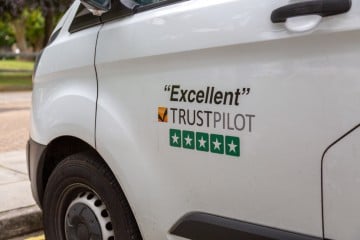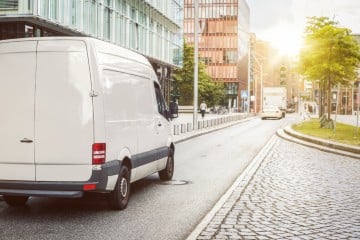What affects the price of van insurance?
Insurers base their prices on a variety of factors, including:
Your van. Vans are categorised into insurance groups. If your Nissan was manufactured before 1 January 2016, it sits in a group between 1-20. If it was manufactured after this date, you'll see groups between 21-50. The lower the group, the less your insurance could cost. Your van's power and value can affect the group it's in. For example, if your van has a powerful engine, repairs are likely to be more expensive. A high-value van is also more attractive to thieves, increasing the risk of theft.
Your age. Younger van drivers tend to pay more for insurance than older drivers. This is because they typically have less experience on the road than older drivers, making them higher risk for accidents. Drivers aged 17-20 pay £3,905(3) for van insurance, on average, compared to drivers aged 41-45 who pay an average of £755(3).
Where you live. Living in an area with a high rate of vehicle crime can mean you pay more than if you lived in a quiet area with low crime. This is because your van is at higher risk of being damaged of stolen.
Your occupation, especially if you use your van for work. Some jobs are considered 'risky' by insurers. For example, if you're a courier and spend long hours on the road, you're at higher risk of being involved in an accident. On average, couriers pay £1,645(3) for comprehensive van insurance, compared to office workers who pay £1,024(3). Likewise, if you're transporting expensive equipment, any claims you make will cost the insurer more. So, your insurance is likely to be more expensive.
Modifications, such as spoilers, alloy wheels or exhausts can also make the repairs process more time-consuming and expensive. All of these factors can mean you pay more for insurance.
Your driving history. If you have any previous claims or driving convictions, you'll see higher insurance costs. Drivers with a single conviction pay an average of £1,009(3), compared to £739(3) for those with no convictions.
(3)Based on Confused.com data, November 2023 - April 2024
How can I save on my Nissan van insurance?
The price to pay to insure your Nissan van depends on your personal circumstances. But, there are a few things you can do to help bring down the cost.
- Don't auto-renew
- Increase your voluntary excess
- Add a named driver
- Let us know if you're a member of a trade federation
- Consider a black box policy
- Increase the security of your van
- Build up your no-claims bonus (NCB)
Don't auto-renew. The best way to check you're getting a good deal on your van insurance is to shop around. Even if your renewal price hasn't increased much from last year, you might still be able to save money by comparing quotes. The best time to shop around is 194 days before your renewal dates.
Increase your voluntary excess. Typically, the more you're willing to pay towards any claims, the less your insurance could cost. The most popular excess amount with our customers is £250, with 44%(4) choosing this level. However, you should make sure you set it at a level you can afford to pay if needed.
Add a named driver. Adding an experienced driver with a good driving history can help lower your costs, especially if you're a young driver. Be honest about who the main driver is though, otherwise you're committing a form of insurance fraud known as 'fronting'.
Let us know if you're a member of a trade federation. We'll ask you this if you select business or haulage use when getting a quote. Some insurers will offer a discount if you're a trade federation member.
Consider a black box policy. These policies involve fitting a small telematics device in your van or using a smartphone app to track your driving. They calculate a driving score based on how, when and where you drive, and the better your score, the lower your insurance could be on renewal. These types of policies can be especially useful for young drivers, who tend to see higher insurance prices.
Increase the security of your van with features like trackers, alarms and immobilisers. These can make it more difficult for thieves to steal your Nissan van.
Build up your NCB. Every year you're insured without making a claim, you get a year added to your NCB. Most insurers offer a no-claims discount, and the bigger your NCB, the bigger your discount could be. With 5 years NCB, customers pay an average of £805(4), compared to £1,553(4) with no NCB.
(4)Based on Confused.com data, November 2023 - April 2024
What insurance can I get for my Nissan van?
Third-party
Third-party, fire and theft
Comprehensive
*Based on Confused.com data November 2023 - April 2024
What are the classes of use for van insurance?
When you get a van insurance quote, we'll ask you what you intend to use your van for. There are 4 classes of use:
Social only. You should choose this option if you intend to use your van for personal trips only. For example, if you use your van on days out. The average cost for a comprehensive policy with social-only use is £692(5).
Social and commuting. This applies to you if you use for van for personal trips as well as commuting to a single permanent place of work. It doesn't include travelling to multiple locations for work, for example if you're a tradesperson. On average, insurance for social and commuting costs £758(5).
Business use. This is sometimes called commercial cover and refers to using your van to travel to multiple job locations. For example, if you're a plumber, shopkeeper or builder and use your van to transport equipment or tools. A comprehensive policy with business use costs £752(5) on average.
Haulage, or 'hire and reward'. You should select this option if you're a delivery driver or courier. It's typically more expensive than other classes of se because you might be transporting hazardous or valuable items. On average, it costs £2,012(5) to insure a van for haulage use.
5Based on Confused.com data November 2023 - April 2024
Nissan van history and facts
Nissan's roots go all the way back to 1911, when it was established under the name Kwaishinsha Motor Car Works by Masujiro Hashimoto. The company, headquartered in Yokohama, Japan, made its first vehicle, the DAT, 3 years later. The company adopted the name Nissan Motor Company in 1934.
Nissan began a worldwide expansion in the 1950s and has grown to become on of the world's biggest motoring names. Nissan eventually started to establish manufacturing facilities outside Japan and opened a UK factory in Sunderland in 1986.
Nissan entered into a strategic partnership with Renault and Mitsubishi in 1999, with a cross-sharing arrangement. The Renault-Nissan-Mitsubishi Alliance now claims to be the global leader in electric vehicle sales.
Nissan's current commercial van and truck range comprises 5 models:
- The ever popular Navara pick-up truck
- The small, all-electric Nissan E-NV200
- The compact NV250
- The mid-sized Primastar
- The larger NV400
With its commitment to electric through the Nissan leaf car and all-electric Nissan E-NV 200 van, there's plenty more to look forward to from Nissan.
One of the more recent offerings from Nissan, launched in 2020, is the e-NV200 XL - a taller variant of the E-NV200 van. The E-NV200 XL offers nearly double the load space of a conventional E-NV200 - 8.0 cubic metres versus 6.0 cubic metres for Nissan's standard all-electric van.
Their most recent launch in the electric range is the Nissan Townstar, a small panel van available in petrol or all-electric forms. The electric options has a range of 183 miles on a full charge.






